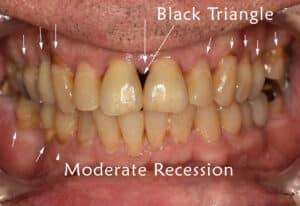
Despite its prevalence, gum recession is a condition that warrants attention. It’s usually a sign of gum disease, which could worsen and progress to more serious issues if you leave it untreated. To protect yourself against gum recession, it is important to understand its causes, the stages of receding gums, and how to treat and prevent it.
What Causes Gum Recession?
Receding gums pull away from the teeth and expose parts of the tooth roots that should be covered. Preventing gum recession requires an awareness of gum disease, one of the most common causes of tooth loss. If your gums look red and swollen or bleed when you brush or floss, you could have gum disease, contributing to gum recession. There are several causes of receding gums:
- Aggressive or rough brushing
- Bacteria
- Certain medications
- Grinding or clenching teeth
- Hormonal changes
- Insufficient dental care
- Poor oral hygiene
- Tobacco use
- Trauma to the mouth
Although common, gum recession occurs gradually, and many people may not realize they have it. You may first notice tooth sensitivity or that some of your teeth look longer than they used to. Although gum recession may take weeks or months, factors like brushing too hard can speed up the process.
Addressing gum recession is crucial to oral health because mild sensitivity could progress to more severe problems, including bone loss and other non-dental health conditions.
What Do the Receding Gums Stages Look Like?
Healthy Gums

Healthy gums are typically pink, firm, and wholly attached to the teeth to provide support. If your gums do not have these characteristics, you are likely experiencing one of four stages of gum recession:
Gingivitis

Gingivitis, the earliest of the receding gum stages, develops from bacteria and plaque accumulation. Although you may not notice any recession immediately, you may feel some tooth sensitivity. During the early stages of receding gums, common symptoms of gingivitis include
- Bad breath or a metallic taste
- Bleeding of gums after brushing or flossing
- Increased spacing between teeth
- Swollen gums
Proper oral hygiene that includes daily flossing and brushing at least two times each day can stave off receding gums, assuming you include regular dental check-ups as part of your oral health regimen. Although there might not be any detectable discomfort, diagnosing gingivitis at this stage is critical to stopping gum recession before it becomes periodontitis.
Early Periodontitis

Early periodontitis is typically the phase that follows gingivitis. During this stage, the gums have become more inflamed, separating from the teeth and forming periodontal “pockets.” When food, plaque, and bacteria collect in these pockets, an infection can set in below the gum line and make the pockets bigger.
Early periodontitis also marks the beginning of bone weakening and loss and decreased immunity against infection. You may also have more pain when flossing or brushing, increased sensitivity, and bad breath.
Moderate Periodontitis

The inflammation and discomfort you previously experienced will likely worsen during moderate periodontitis. The advanced gum recession also includes more bone loss and the loosening, shifting, or loss of teeth due to the spread of plaque and bacteria. You will also notice that your gums are more swollen and may produce a discharge that tastes bad.
Advanced Periodontitis

Tooth loss is most likely to occur during advanced periodontitis. Painful abscesses also characterize this stage due to the infection spreading beneath the gums. The teeth that do remain are probably loose or about to come out because they do not have enough strong bone and tissue to keep them in place.
Talking, eating, or drinking can become painful and uncomfortable during advanced periodontitis. Without the proper dental care, you also become more susceptible to other health conditions:
- Arthritis
- Some forms of cancer
- Diabetes
- Heart attack
Treating Gum Recession
Prevention is the best form of treatment for receding gums. It helps to schedule regular dental check-ups, brush and floss daily, and continually check your teeth and gums for early signs of gum disease or other changes. You can also prevent gum recession by eating a healthy diet and avoiding tobacco products.
Unfortunately, any gum tissue you lose during recession cannot grow back. However, catching gum disease early makes it easier to keep it from progressing. If your dentist detects early signs of gum recession or gingivitis during a routine visit, they will recommend treatment to meet your dental health needs. They also might need you to schedule more frequent dental visits.
For any signs of periodontitis, your dentist may recommend surgery if preventive care, professional cleaning, or antibiotics do not improve your condition. One common intervention is scaling and root planing, which involves using a curette or surgical scraping tool to remove the plaque and tartar below the gum line. After scaling, the dentist uses root planing to smooth the roots so that the gums will reattach.

Your dentist may also perform flap surgery to lift the gums back for easier cleaning before suturing them back together. If you have already reached advanced periodontitis or suffered extensive bone and tissue damage, you may need bone grafting or gum grafting to restore damaged or lost tissue.
- Dental Implant Pros and Cons - August 26, 2023
- Receding Gums Stages - August 12, 2023
- When Is It Too Late for Gum Grafting? - July 8, 2023


